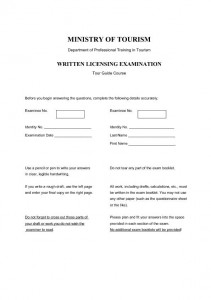
For starters, I will say that I feel really good about my performance on the exam, and am fairly certain that I will pass. Obviously, there is no way of knowing for sure until I hear back from them (probably in another 2-3 weeks), but I’ll say that I’ll be relatively surprised if I don’t pass. Mainly this is because, while I would not say this exam was easy, I don’t think it was particularly tough, nor did I think there was any part of it that was “out there” or designed to screw with us. It was fairly straightforward, and I feel like I was about as prepared as I could be. I can’t really imagine getting a test that would be preferable to this one, which is why I would be disappointed if I failed this one.
Before I actually get into the details of the exam itself, I wanted to discuss some of the numbers related to my class. How many students took the exam, etc. As you know, in the past there was some suspicion about the way the test was administered and the pass/fail rate. I also wrote about the actual numbers of people who passed in a different post. And of course, there are also people who drop out of the course along the way or don’t actually sit for the exam in the first place for various reasons.
In my course, we began with 37 students (not counting a few who signed up and then dropped out after 1 or 2 classes, clearly deciding it wasn’t for them). Along the way, 4 more people dropped out of the course at various times for various reasons, leaving us to end the course with 33 people. Of those 33, 22 actually sat to take the exam this past week — thus 2/3 of those who finished the course.
Of the other 11, a few either chose not to due to lifecycle changes (marriage, kids, etc.) or never intended to take the exam, and were just taking the course for the fun and knowledge. A few others have not yet met all the requirements (you cannot miss more than a certain number of field trips or classes), and are planning to make them up and take the exam during a future administration. And a few others wanted to take the exam, but did not perform well enough on the internal tests along the way and so were not allowed to sit for the licensing exam.
Of the 22 who did take the exam, my guess (and it is purely a guess, though an educated one) is that at least half should pass, if not more. But we will see once the actual results come through.
Now on to the exam itself. The multiple choice section always has a few questions that everyone looks at in confusion, not even recognizing the topic they are asking about. An example of that on this test was question 22:
“Shabbtai Luzinsky” became famous upon its arrival at the following beach:
- Nitzanim
- Atlit
- Palmachim
- Kfar Vitkin
Very few students that I spoke to, from Hebrew courses as well, had ever heard of “Shabbtai Luzinsky.” (FYI, the correct answer is apparently Nitzanim.) But that’s fine. A couple of questions like that is no big deal, since you can skip 5 questions, and since you don’t need to get 100% right.
Other questions were actually incorrect. Such as number 17:
The poetic prayer “u-Netanneh Tokef” is said at:
- Rosh Hashana
- The Fast of Gedaliah (Tzom Gedaliah)
- Yom Kippur
- Tisha B’Av (the 9th of Av)
As many of you may have noticed, there are really two right answers here — Rosh Hashana and Yom Kippur, in most congregations. Interestingly, while we were taking the exam, all of the coordinators of the different courses were sitting together outside, already going over all of the questions, figuring out what the correct answers were for each question and identifying problematic questions (such as this one) that they’d be appealing.
An additional challenge that can make some questions incorrect (and needing of appeal) is the translation into English. Question 46, for example:
A Sunfish (Pterois) is:
- A predatory fish common to the Red Sea
- A kind of glowworm
- A night butterfly
- An edible fish in the Sea of Galilee
Many of us English-speaking North Americans have fished in lakes for a freshwater fish named sunfish, so we assumed it would have to be the fourth answer. However, the correct answer was apparently supposed to be the first. The problem was a mistranslation. The Pterois is actually called a lionfish in English, but in Hebrew it is called a Zaharon. That word could be translated as “shiner,” which presumably led to the mistranslation as a sunfish.
Beyond these kinds of things, however, most of the questions were straightforward and not too tricky. An example (Number 3):
The Biyar aqueduct feeds into:
- Solomon’s Pools
- The water cisterns at Herodion
- The Bethesda pool
- The Struthion pool
The correct answer here is Solomon’s Pools, but the other answers could all attract someone who doesn’t know the answer exactly. Biyar feeds into Solomon’s Pools, but another aqueduct runs from Solomon’s pools to Herodion. (By the way, Solomon’s Pools actually have nothing to do with Solomon, but that’s for a different time.) Water also flowed from Solomon’s Pools to Jerusalem, which is what might lead someone to think about the other two answers. The water that came to Jerusalem supplied the area of today’s Old City, and both of the other two answers are located inside the Old City and acted as water reservoirs. But they are to the north of the Temple Mount and were fed by rainwater that ran into them.
I definitely got a few wrong that I should have gotten right, sometimes changing my answers. But overall, I got at least 33 right, and maybe more depending on appeals. That is a good start, giving me at least 21 points heading in to the itinerary section.
And what about that itinerary section? Here were the three options:
Group One was anthropology students from abroad, focused on contemporary religions in Israel, and had to focus on at least 4 religions (including minority religious groups). The tour was in the central part of the Upper and Lower Galilee, but did not include the Galilee Coastal Plain (i.e. no Akko) or the Etzba HaGalil/Galilee Panhandle, but did include Tiberias.
Group Two was touring Crusader and Mamluk sites, looking at history, archaeology and architecture. The tour area covered the smallest area of the three, from just north of Herzliya to Tel Aviv-Yaffo on the coastal plain, across to Road 6 (thus including Antipatris), and then basically covered a thin swath moving south east to end in Jerusalem.
I chose Group Three, so I will give you the full description:
You must prepare an itinerary for a “Birthright” group on the subject of settlement of the South throughout the ages. The tour embarks from Ashdod on Monday at 08:00 AM and finishes at Yeruham on Tuesday at 19:00 PM.
Please note:
- You must stay within the borders (geographic parameters) delineated on the map.
- The program must present at least four periods, including Zionist settlement.
- The first day must be – geographically – between Ashdod and Beersheva and the second day must take place south of Beersheva.
- The Guiding point must be connected to the subject.
(Criteria 1 and 4 above are included in every itinerary option, by the way.) The area of Group Three’s itinerary was fairly large, though being located in the Negev, it still has lots of empty space between the location and thus requires more physical space. The boundaries went from Ashdod to Kfar Menachem, then south in a straight line to the east of road 40, cutting southeast and east to the north of road 31 until just past Arad. Then it cut south, to the east of road 258 and 206, cut west through the Makhtesh HaGadol via 225, and then southwest to the Sinai border just south of Shivta and Nitzanim. From there, the border runs back up to Ashdod, following the border and coastline.
You’ll notice, by the way, that one of the criteria of this Group is a bit vague. What exactly is meant by “between Ashdod and Beersheva” and by “south of Beersheva?” I mean, Arad was clearly on the map, but it is technically north of Beersheva. Does that men you have to do it on Day One? That would be fairly silly from a logistical perspective, so they must have intended that on day two, the “south of Beersheva” day. Similarly, what about things that are southwest of Beersheva? They might still be seen as “between Ashdod and Beersheva,” right? These were assumptions I made when planning my itinerary, but they are also things that I realize they can take points off for, if they are looking for a way to “screw me.” Hopefully they won’t.
For those who are interested, here is the list of stops, in order, that I did on my itinerary…
Day 1: Ad Halom Bridge – Old Nitzanim – Negba – Ashkelon – Ruhama – Sderot (including lunch) – Kfar Maimon – Revivim – Ramat Hovav (brief stop, staying on the bus) – Beer Sheva
Day 2: Negev Brigade Memorial – Tel Beer Sheva – Hatzerim Air Force Museum – Tel Arad (lunch in Arad itself) – Brightsource Energy solar test facility at Rotem Industrial Park – Mamshit – Makhtesh HaGadol – Yeruham
My extended guiding point was at Kibbutz Revivim.
Ultimately, all three itineraries, in my opinion, were completely doable, with none that were “out of left field.” There were different pluses and minuses of each, but overall they were all decent. And the same was true of the multiple choice. When I receive word about whether I passed or failed, I will let you know, and if I have a number regarding the pass/fail rate in my course, I will tell you as well. And then, as we approach the oral exam, I’ll blog a bit about that too.

Hello, i work as a tour operator in Nigeria and i am intrested in focusing on the land of isreal as we have large number of christians in Nigeria more any other place in Africa because of the large population. I want to come to isreal for preparatory course and as well write the license tour guide exam.
which of the school can you recommend to a foreigner? It should be a cost effective and not more than 6months duration class ..
Thanks
excellent analysis of tour guide exam
Dear Joel,
hi
i am almost at the end of the english tour4 guide course and hopefully will pass in december
May i ask if you could assist me
Do you have 3-4 example 2 day trips that you may have prepared prior to the exam for revision
If so, i would appreicate it if you could send them to me
If there is any patment involved I will glady pay for them
all the best
Effi